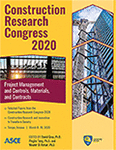Construction Research Congress 2020
Revisiting the Roles of Structural Engineering Design Professionals under Their Increasing Risks and Associated Liabilities
Publication: Construction Research Congress 2020: Project Management and Controls, Materials, and Contracts
ABSTRACT
Structural engineering is an age-long profession which historically has played a central role in shaping our landscapes and societies with countless iconic structures. However, throughout the years, the role of structural engineers has significantly changed. From the “master builder”, responsible for all project aspects, their role nowadays is often confined to ensuring structural integrity. They are considered as supporting members led by others and are seldom involved in project decision-making. The paper aims at addressing the marginalized role of structural engineers which currently is not aligned with the vital importance of their profession. The methodology adopted consisted of a literature review to explore two main aspects. First, the role and competencies of structural engineers were investigated with respect to established and emerging fields such as structural and construction safety, integrated design, new project delivery methods, sustainable design, BIM, and other technological developments, including artificial intelligence and data analytics. Second, the new increased responsibilities, challenges, and liabilities that structural engineers are subjected to were identified. The findings revealed that in most fields, structural engineers play secondary roles especially as compared to architects. Unrealistic requirements and deadlines are frequently imposed on them and they operate in a legal context that does not properly shield them from professional liabilities. This is often hindering their performance as they become more conservative and averse to risk to the detriment of innovation and value engineering. Structural engineers should be proactive in redefining a more prominent and wider role for themselves. They should also regain control of decisions that directly affect their work. This will help their profession reach new heights while mitigating their risks and liabilities.
Get full access to this article
View all available purchase options and get full access to this chapter.
REFERENCES
AIA (2007). “Integrated project delivery: A guide.” The American Institute of Architects, <http://info.aia.org/siteobjects/files/ipd_guide_2007.pdf> (July 15, 2019).
ASCE (2007). “The vision for civil engineering 2025.” American Society of Civil Engineers, <http://www.asce.org/uploadedFiles/Vision_2025__New/TheVisionforCivilEngineeringin2025_ASCE.pdf> (July 15, 2019).
ASCE (2009). “Achieving the vision for civil engineering in 2025, a roadmap for the profession.” American Society of Civil Engineers, <https://www.asce.org/uploadedFiles/About_Civil_Engineering/Content_Pieces/vision2025-roadmap.pdf> (July 15, 2019).
Baker, W. F. (2008). “The future for structural engineers: Challenges and opportunities.” Struct Eng, 86(14), 143-145.
CASE (2009). “Position statement on separate structural engineering licensure.” Council of American Structural Engineers, <https://docs.acec.org/pub/D1A2CAC7-CD41-7DBA-9045-197BF2971A07> (July 15, 2019).
CASE (2012). “General considerations for the use of performance-based design approach on structures.” Council of American Structural Engineers, <https://docs.acec.org/pub/D19201F3-A05A-DE1D-85B9-6ACE40A21EC4> (July 15, 2019).
Chaudhary, M. T. A., and Piracha, A. (2013). “Examining the role of structural engineers in green building ratings and sustainable development.” Aust. J. Struct. Eng., 14(3), 217-228.
Cheatham, B., Javanmardian, K., and H., S. (2019). “Confronting the risks of artificial intelligence.” McKinsey Quaterly, <https://www.mckinsey.com/business-functions/mckinsey-analytics/our-insights/confronting-the-risks-of-artificial-intelligence> (July 15, 2019).
D'Amico, B., Myers, R. J., Sykes, J., Voss, E., Cousins-Jenvey, B., Fawcett, W., Richardson, S., Kermani, A., and Pomponi, F. (2019). “Machine Learning for Sustainable Structures: A Call for Data.” Structures, 19, 1-4.
Guscetti, G., Pirazzi, C., Snozzi, F., and Walgenwitz, M. "Structural engineers - Added value for successful design." Proc., IABSE Conference, Geneva 2015: Structural Engineering: Providing Solutions to Global Challenges, International Association for Bridge and Structural Engineering (IABSE), 518-525.
Kaethner, S. C., and Burridge, J. A. (2012). “Embodied CO2 of structural frames.” Struct Eng, 90(5), 33-40.
Kalach, M., Abdul-Malak, M. A., and Srour, I. "Multi-tiered professional liability coverage for designers and contractors under design-build project delivery." Proc., Construction Research Congress 2018: Construction Project Managemen, CRC 2018, American Society of Civil Engineers (ASCE), 723-732.
Kalach, M., Abdul-Malak, M. A., and Srour, I. (2019). “Liability Exposure and Indemnity for Architecture and Engineering Professionals Acting as Independent Consultants or Design Subcontractors.” J. Legal Aff. Disput. Resolut. Eng. Construction, 11(4).
Naeim, F. (2005). “Structural engineers and the law.” Struct. Des. Tall Spec. Build., 14(5), 439-445.
Paul, S. C., van Zijl, G. P. A. G., and Tan, M. J. (2018). “A review of 3D concrete printing systems and materials properties: current status and future research prospects.” Rapid Prototyping J., 24(4), 784-798.
Rubin, R. A., Quintas, B., and Roth, D. (2004). “Changing role of the civil engineer in society.” J Prof Issues Eng Educ Pract, 130(1), 5-7.
Schinnerer, V. O. (n.d.). "VEP module 1-2: Legal liability of design professionals." <https://www.schinnerer.com/risk-mgmt/Documents/UnprotectedFiles/AIA-Members/vep1-2.pdf> July 26, 2018.
Schmidhuber, J. (2015). “Deep Learning in neural networks: An overview.” Neural Netw., 61, 85-117.
SEI (2013). “A vision for the future of structural engineering and structural engineers: A case for change.” Structural Engineering Institute, <https://www.asce.org/uploadedFiles/visionforthefuture.pdf> (July 15, 2019).
Storey, E. J. (2017). “From technical expert to business consultant–the changing role of the structural engineer.” Aust. J. Struct. Eng., 18(4), 233-237.
Terwel, K., and Vambersky, J. "Possible critical structural safety factors: A literature review." Proc., 6th Congress on Forensic Engineering 2012: Gateway to a Better Tomorrow, 408-417.
Terwel, K. C., and Jansen, S. J. T. (2015). “Critical factors for structural safety in the design and construction phase.” J. Perform. Constr. Facil., 29(3).
Uihlein, M. S. (2015). “Integrating structure and architecture: Guidance for the structural engineer.” Pract Period Struct Des Constr, 20(4).
Zhang, J., Li, H., Zhao, Y., and Ren, G. (2018). “An ontology-based approach supporting holistic structural design with the consideration of safety, environmental impact and cost.” Adv Eng Software, 115, 26-39.
Information & Authors
Information
Published In
Construction Research Congress 2020: Project Management and Controls, Materials, and Contracts
Pages: 1001 - 1011
Editors: David Grau, Ph.D., Arizona State University, Pingbo Tang, Ph.D., Arizona State University, and Mounir El Asmar, Ph.D., Arizona State University
ISBN (Online): 978-0-7844-8288-9
Copyright
© 2020 American Society of Civil Engineers.
History
Published online: Nov 9, 2020
Authors
Metrics & Citations
Metrics
Citations
Download citation
If you have the appropriate software installed, you can download article citation data to the citation manager of your choice. Simply select your manager software from the list below and click Download.
